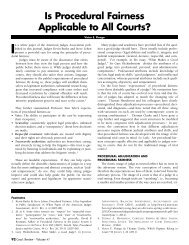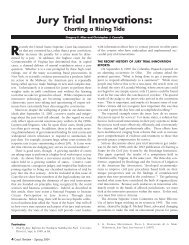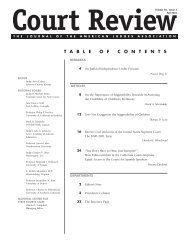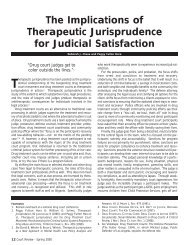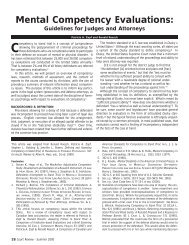Special Issue on Procedural Fairness - American Judges Association
Special Issue on Procedural Fairness - American Judges Association
Special Issue on Procedural Fairness - American Judges Association
- No tags were found...
You also want an ePaper? Increase the reach of your titles
YUMPU automatically turns print PDFs into web optimized ePapers that Google loves.
ec<strong>on</strong>omic loss based <strong>on</strong> a variety of factors (e.g., age, income),thereby relying primarily <strong>on</strong> principles of efficiency and merit.However, Feinberg implemented an equality norm for n<strong>on</strong>ec<strong>on</strong>omicloss, awarding $250,000 per victim and $100,000per spouse and dependent child. Many claimants, and <str<strong>on</strong>g>Special</str<strong>on</strong>g>Master Feinberg himself, thought the Fund should haveadhered to a principle of equality for all compensati<strong>on</strong>. 23 As wediscuss below, an awareness of these principles can informjudicial performance.Most experimental research has focused <strong>on</strong> the distributi<strong>on</strong>(or redistributi<strong>on</strong>) of desirable resources (i.e., goods) ratherthan the distributi<strong>on</strong> of undesirable commodities or bads. Inthe c<strong>on</strong>text of the justice system, civil cases are c<strong>on</strong>cernedmainly with the redistributi<strong>on</strong> of a good (m<strong>on</strong>ey), while criminalcases are c<strong>on</strong>cerned mainly with the distributi<strong>on</strong> of a bad(punishment). This is an important distincti<strong>on</strong>, as several theoristshave argued that different distributive norms should predominatein allocating different types of goods or in allocatingthe same good in different c<strong>on</strong>texts. 24 For example, Elster c<strong>on</strong>tendsthat the principle of need should be central in allocatingorgans for transplantati<strong>on</strong>, whereas merit should prevail inadmitting students to college. 25 Thus, the same principlesmight reas<strong>on</strong>ably not apply in civil versus criminal cases, oreven for different types of cases within each system (e.g.,crimes against pers<strong>on</strong>s vs. crimes against property).INDIVIDUAL DIFFERENCES IN PERCEPTIONS OFDISTRIBUTIVE FAIRNESSThe experimental literature <strong>on</strong> distributive justice showsthat people’s preferences differ depending <strong>on</strong> a number ofdemographic characteristics, such as race/ethnicity, gender,nati<strong>on</strong>ality, and socioec<strong>on</strong>omic status. 26 As suggested by Burkeand Leben, minorities differ in their approval ratings of thecourt system. 27 These percepti<strong>on</strong>s are based not <strong>on</strong>ly <strong>on</strong> theway in which minority group members are treated by the justicesystem, but also the probabilityof an unfair outcome.The threat of “worse results” ismost prominent for African<strong>American</strong>s, who account foralmost half of the incarceratedpopulati<strong>on</strong> and represent 41%percent of the populati<strong>on</strong> <strong>on</strong>death row. 28 In general, African<strong>American</strong> citizens have loweropini<strong>on</strong>s of the criminal justicesystem and are less c<strong>on</strong>fidentthan others in the neutralityand legitimacy of thecourts. 29The experimentalliterature <strong>on</strong>distributive justiceshows thatpeople'spreferences differdepending <strong>on</strong> anumber ofdemographiccharacteristics....In a study by Miller and colleagues, the researchers foundthat Black and White men and women differed in their recommendedcriminal sancti<strong>on</strong>s for c<strong>on</strong>victed offenders. 30 WhereasBlacks tended to ascribe to a justice philosophy that c<strong>on</strong>sideredthe individual offender, Whites were more likely toemploy a justice philosophy that focused <strong>on</strong> meting out punishmentthat was proporti<strong>on</strong>ate in severity to crime seriousness.In other words, Whites’ judgments were more centered<strong>on</strong> characteristics of the offense (i.e., the seriousness of thecrime), whereas Blacks’ judgments were more centered <strong>on</strong> thesocial characteristics of the offender. Research <strong>on</strong> justice preferencesin n<strong>on</strong>-legal c<strong>on</strong>texts has similarly found that individualsof different races favor different justice principles.Specifically, minorities are more skeptical than Whites aboutthe relati<strong>on</strong>ship between merit and outcomes, and they arecorresp<strong>on</strong>dingly less sensitive to variati<strong>on</strong>s in merit. 31One’s percepti<strong>on</strong>s of distributive justice outcomes will alsovary as a functi<strong>on</strong> of socioec<strong>on</strong>omic status, which is correlatedwith race in the U.S. As Blacks are c<strong>on</strong>sidered, <strong>on</strong> average, tobe closer to crime than Whites (i.e., more likely to be victim-21. The Fund has generated c<strong>on</strong>siderable commentary, much of itwritten from a social justice perspective. The following sourcesare especially helpful: LLOYD DIXON & RACHEL K. STERN,COMPENSATION FOR LOSSES FROM THE 9/11 ATTACKS (RAND Corp.2004); KENNETH R. FEINBERG, WHAT IS LIFE WORTH? THEUNPRECEDENTED EFFORT TO COMPENSATE THE VICTIMS OF 9/11(2005) [hereinafter WHAT IS LIFE WORTH]; KENNETH R. FEINBERG ETAL., FINAL REPORT OF THE SPECIAL MASTER FOR THE SEPTEMBER 11THVICTIM COMPENSATION FUND OF 2001 (2004), available athttp://www.usdoj.gov/final_report.pdf.; 53 DEPAUL L. REV. (2003)(special issue <strong>on</strong> the Fund).22. Air Transportati<strong>on</strong> Safety and System Stabilizati<strong>on</strong> Act of 2001,Pub. L. No. 107-42, 49 U.S.C. § 40101 (2001).23. FEINBERG, WHAT IS LIFE WORTH, at 177-88 (<strong>on</strong> Feinberg’s evaluati<strong>on</strong>of the Fund); Brian H. Bornstein & Susan Poser, Percepti<strong>on</strong>sof <strong>Procedural</strong> and Distributive Justice in the September 11th VictimCompensati<strong>on</strong> Fund, 17 CORNELL J.L. & PUB. POL’Y 75, 94 (2007)(<strong>on</strong> claimants’ percepti<strong>on</strong>s).24. See, e.g., JON ELSTER, LOCAL JUSTICE (1992); MILLER, supra note 4;MICHAEL WALZER, SPHERES OF JUSTICE: A DEFENSE OF PLURALISM ANDEQUALITY (1983); J<strong>on</strong> Elster, Justice and the Allocati<strong>on</strong> of ScarceResources, in PSYCHOLOGICAL PERSPECTIVES ON JUSTICE: THEORY ANDAPPLICATIONS 259, 259-278 (Barbara A. Mellers & J<strong>on</strong>athan Bar<strong>on</strong>eds., 1993).25. Elster, Justice and Allocati<strong>on</strong>, supra note 24, at 259.26. See generally Michelbach et al., supra note 8; Scott et al., supranote 7; Peter B. Wood & David C. May, Racial Differences inPercepti<strong>on</strong>s of the Severity of Sancti<strong>on</strong>s: A Comparis<strong>on</strong> of Pris<strong>on</strong> withAlternatives, 20 JUST. Q. 605 (2003).27. See, e.g., David B. Rottman & Alan J. Tomkins, Public Trust andC<strong>on</strong>fidence in the Courts: What Public Opini<strong>on</strong> Surveys Mean to<strong>Judges</strong>, 36 CT. REV. 24 (1999); DAVID B. ROTTMAN ET AL.,PERCEPTIONS OF THE COURTS IN YOUR COMMUNITY: THE INFLUENCE OFEXPERIENCE, RACE AND ETHNICITY: FINAL REPORT (Nati<strong>on</strong>al Centerfor State Courts, 2003).28. Wood & May, supra note 26, at 605-606.29. M. SOMJEN FRAZER, THE IMPACT OF THE COMMUNITY COURT MODEL INDEFENDANT PERCEPTIONS OF FAIRNESS: A CASE STUDY AT THE REDHOOK COMMUNITY JUSTICE CENTER (2006), available athttp://courtinnovati<strong>on</strong>.org/_uploads/documents/<strong>Procedural</strong>_<strong>Fairness</strong>.pdf.30. John L. Miller, Peter H. Rossi & J<strong>on</strong> E. Simps<strong>on</strong>, Percepti<strong>on</strong>s ofJustice: Race and Gender Differences in Judgments of AppropriatePris<strong>on</strong> Sentences, 20 L. & SOC’Y REV. 313 (1986).31. Michelbach et al., supra note 7, at 530, 536.Court Review - Volume 44 75




